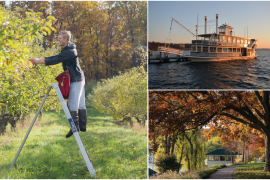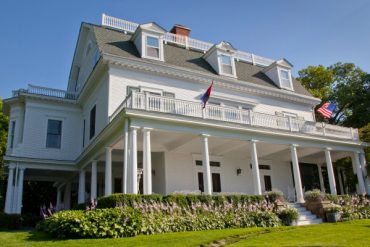By Anne Morrissy | Photos by Holly Leitner
If you’ve spent any time on a boat on Geneva Lake, you’ve probably seen the majestic white sails of the racing boats from the Lake Geneva Yacht Club (LGYC). One of the most competitive sailboat racing clubs in the country, the LGYC runs races most evenings of the week, as well as Saturday and Sunday mornings, from Memorial Day through mid-September. No two race courses are ever the same — they are determined by the race officials each day, and depend on the direction and strength of the wind. However, for those interested in spectating the races from a powerboat, here are some general guidelines:
- Typical race courses involve the sailboats crossing an imaginary starting line and heading toward an orange or yellow buoy, known as a mark. When they reach the mark, they make a half-circle around it, being careful not to make contact with the buoy (this incurs a penalty). They then head back toward a second mark in the general area of the starting line. A full race can consist of between 1 to 3 1⁄2 laps around the course, before the boats finish by crossing an imaginary finish line.
- Because they rely on wind power, sailboats cannot sail in a direct line between the starting line, the marks and the finish line. Instead, they have to plot a zigzag path between all of them, in order to maximize the wind in their sails. This creates a roughly diamond-shaped racecourse. To be respectful of the sailboats, powerboats should try to remain outside of this diamond shape.
- Remember that sailboats don’t have brakes and they don’t have gas pedals. They cannot easily stop or speed up: instead, they must travel at a steady pace that is determined by the wind. As a result, sailboats always have right-of-way over powerboats. If you see a sailboat headed toward your powerboat, you should maneuver out of their way.
- The kind of sailboats that are raced on Geneva Lake are called scows, unique for their flat-bottomed hulls. Because of this, they are greatly affected by large waves and wake. To show respect for the sailboats, it’s best to maintain a slow-no-wake speed within at least 100 yards of the race course. (For reference, 100 yards is roughly half the distance between the shore and a slow-no-wake buoy.)
- To know when the race is coming to an end and the boats are crossing the finish line, look for a blue flag flying from the LGYC’s committee boat (called the “Flagship”). You can also listen for air horn blasts from the Flagship, which indicate the first three boats to cross the finish line in each class. When the race is over, the boats may return to the starting line to set up for a second race, or they may head en masse to the LGYC pier. During this time, powerboats should steer wide around them if possible.






